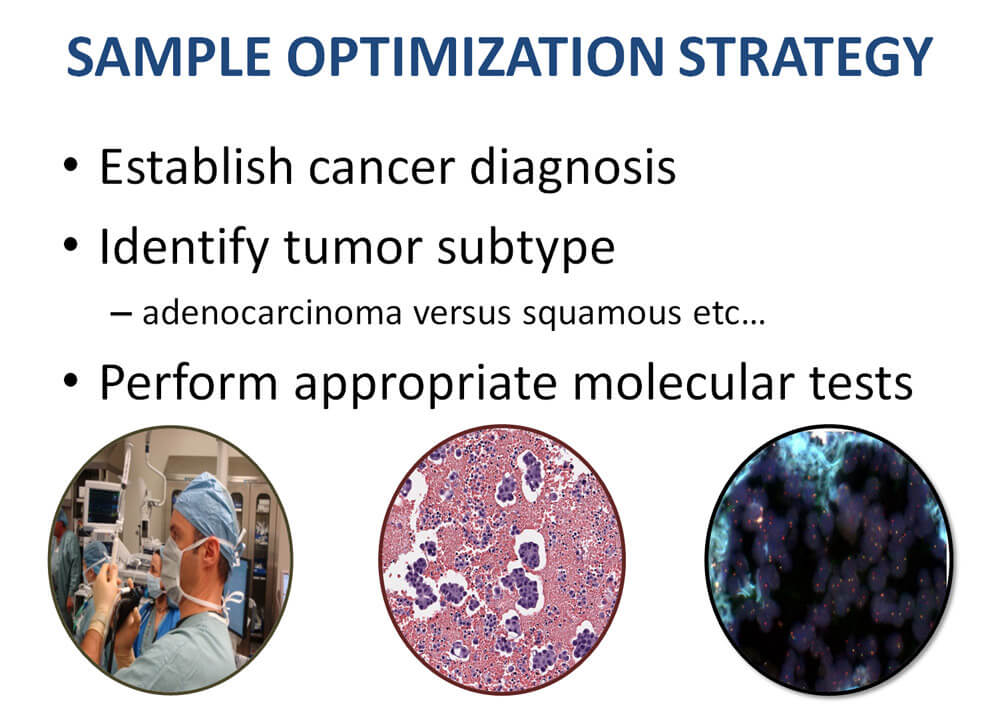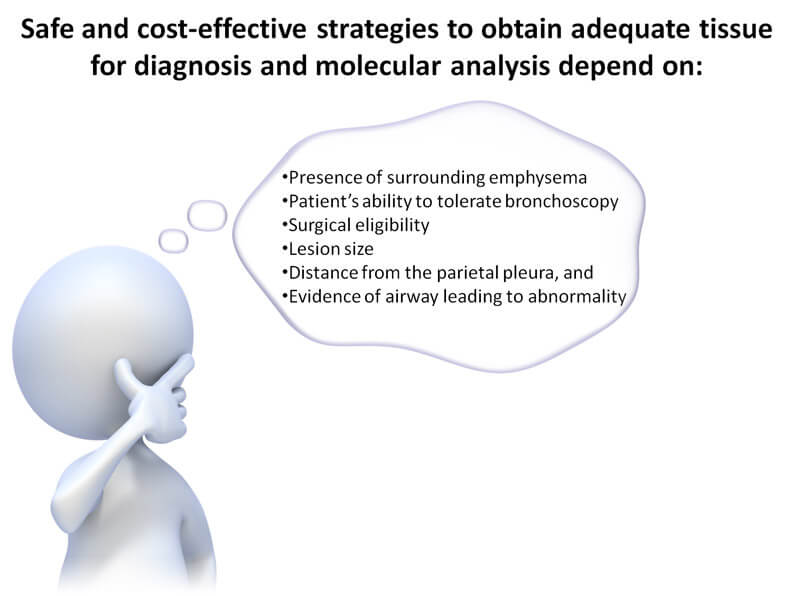 | . | Step 20 of 41 |
 |
Clinical Stem 3
A patient with right upper lobe adenocarcinoma progressing on biomarker-directed therapy
A patient with right upper lobe adenocarcinoma progressing on biomarker-directed therapy
Answer D
At this conference, pathologists noted that tissue requirements for molecular analysis may exceed those for diagnostic cytologic or histologic examination. The pulmonologist noted that in peripheral parenchymal lesions, a systematic review showed an overall sensitivity of 69% for conventional bronchoscopy with transbronchial biopsy, brushings and lavage, but without electromagnetic navigation or radial ultrasound assistance. Brushing alone had a sensitivity of 52 %, whereas transbronchial biopsy had a sensitivity of only 46%. BAL and washing had a sensitivity of 43%. The size of the lesion impacts yield. The sensitivity of all modalities for peripheral lesions less than 2 cm was 0.33 compared to 0.62 for lesions greater than 2 cm. At least 4-5 biopsies should probably be performed to obtain sufficient material for molecular testing.
The Interventional radiologist said that diagnostic yield for transthoracic CT-guided biopsy and needle aspiration is reportedly greater than 90%. She argued that CT-guided biopsy was the optimal procedure in this patient because adequate quantity and quality of lung tissue can be obtained for molecular testing if multiple passes are performed. Complications include hemorrhage and pneumothorax, which, in high-risk patients might prompt a preference for a bronchoscopic approach. The pulmonologist responded that EBUS-TBNA from the interlobar node could be performed at the time of bronchoscopy with transbronchial biopsy, brushings and lavage from the right upper lobe mass. Using EBUS-TBNA, cytology and tissue cores for histology are obtained that are adequate for molecular testing.


The rates of successful molecular testing with small volume biopsies and cytology specimens obtained by transthoracic and bronchoscopy needle aspiration-biopsy probably vary depending on the fixation method and the extent of analysis performed. In one study, molecular analysis was successful in only 48% of fresh specimens submitted for gene expression profiling. On the other hand, the use of fresh frozen biopsies from TBNA submitted for EGFR testing alone was successful in 100% of cases.
Click here to download supplement materials (1)
Click here to download supplement materials (2)
References:
- Osarogiagban RU, Phelps G, McFarlane J et al. Causes and consequences of deviation from multidisciplinary care in thoracic oncology. J Thorac Onc 2011;6:510-516.
- Schreiber G, McCrory DC. Performance characteristics of different modalities for diagnosis of suspected lung cancer: summary of published evidence. Chest.2003 Jan;123(1 Suppl):115S-128S.
- Muley T, Herth FJF, Schnabel P, Dienemann H, Meister M. From tissue to molecular phenotyping: Pre-analytical requirements Heidelberg Experience. Transl Lung Cancer Res 2012;1(2):111-121.
- Nakajima T, Yasufuku K, Suzuki M, et al. Assessment of epidermal growth factor receptor mutation by endobronchial ultrasound-guided transbronchial needle aspiration. Chest. 2007;132(2):597-602.
- Billah S, Stewart J, Staerkel G, et al. EGFR and KRAS mutations in lung carcinoma: molecular testing by using cytology specimens. Cancer Cytopathol. 2011;119(2):111-117.
- Reck M, Hermes A, Tan EH et al.. Tissue sampling in lung cancer: a review in light of the MERIT experience. Lung Cancer 2011; 74: 1?6).
- Cheung YC, Chang JW, Hsieh JJet al. Adequacy and complications of computed tomography-guided core needle biopsy on nonsmall cell lung cancers for epidermal growth factor receptor mutations demonstration: 18-gauge or 20 gauge biopsy needle. Lung Cancer 2010; 67: 166?169)







